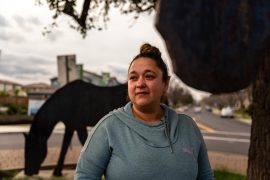Study Says Undercount Of Deaths From Police Violence Is ‘Vast’
A study published in the Lancet says official figures didn’t represent 55.5% of the true total deaths from police violence that occurred over four decades. Meanwhile, USA Today notes police kill more people in Oklahoma than any other state. News outlets report on other health and race issues.
Bloomberg:
New Study Quantifies Vast Undercount Of Police Deaths
More men died of police violence than of testicular cancer, or lymphoma, or STDs in the U.S. in 2019. Depending on where you get your information, that could come as a surprise, or a grave confirmation. A new study published in The Lancet found that a government-run database has undercounted the number of deaths at the hands of police in the U.S. by more than half. That’s unacceptable, said Fablina Sharara, one of the lead authors of the report and a researcher for the Institute for Health Metrics and Evaluation at the University of Washington. “We rely on official statistics for every other cause of death: for cancer, for example, or homicide,” she said. “From our perspective, it's important for the official statistics to be accurate for every cause.” (Holder, 10/1)
USA Today:
Study: Police Kill More People In This State Than Any Other. And Many Deaths Go Unreported
Oklahoma has the highest mortality rate of police violence of all 50 states and the highest rate of underreporting the killings, according to estimates in a study released Thursday. About 84% of police killings in the state from 1980 to 2018 were unreported or misclassified in official government reports, according to the peer-reviewed study in The Lancet, one of the world's oldest and most renowned medical journals. (Hauck, 9/30)
In other news about health and race —
The New York Times:
More Hispanic Americans Have Received Covid Vaccinations, Poll Shows
The share of Hispanic adults in the U.S. who say they have received at least one dose of coronavirus vaccine reached 73 percent in September, an increase of 12 percentage points from July, according to a Kaiser Family Foundation survey. The increase was the fastest of any demographic group in the survey, and it put the reported vaccination rate for Hispanic adults slightly ahead of that of white adults. (Medina, 9/29)
Los Angeles Times:
For Black Community, Nicki Minaj's Vaccine Drama Is No Joke
Dr. Kirsten Bibbins-Domingo, an epidemiologist, physician and researcher at UC San Francisco, has been a voice in the fight against COVID-19 on behalf of minorities. She is not surprised at the hip-hop community’s overall skepticism. “Blacks and Latinos have historically had a mistrust or a wait-and-see attitude,” toward vaccines, she explains, adding that the hesitancy, especially among Black people, goes way beyond the Tuskegee Experiment, the infamous syphilis study that began in 1932 recruiting Black men from Alabama who were never told by doctors that they had the disease. (Murphy, 9/27)
Health News Florida:
The Suicide Rate Among Black Children Remains High. An Expert Urges Families To Seek Help
Mental health shouldn't be seen as different from physical health. Think of the brain as just needing some extra attention. "When someone even describes any symptoms around depression or anxiety, there tends to be that pulling back," said Veronica James, founder and CEO of Our Children Our Future in Hollywood. "That really is very unfortunate because it prevents many people from getting the preventive services they need that could also safeguard them from more serious mental disturbances later in life. (Zaragovia, 9/30)
NPR:
2020 Census: Many Latinos Identified With 'Some Other Race'
Nationwide, some 45 million Latinos did not identify last year with any of what the federal government considers to be the major racial groups, and they were recorded as "Some other race" after either just marking that box or writing in a response that the bureau sorted into that category. In recent decades, many immigrants have also come to see "Some other race" as their preferred check box, especially people with roots in the Middle East or North Africa (whom the U.S. government categorizes as "White") or from Afro-Caribbean groups. Altogether totaling close to 50 million — or more than 1 in 7 people living in the U.S. — their numbers helped the catchall category rise through the ranks of census results. (Lo Wang, 9/30)






